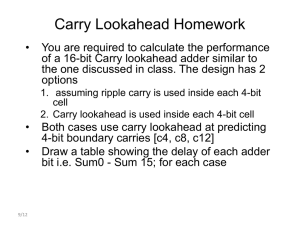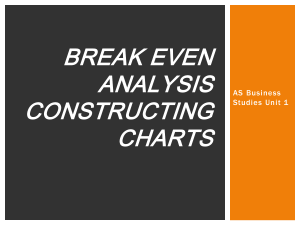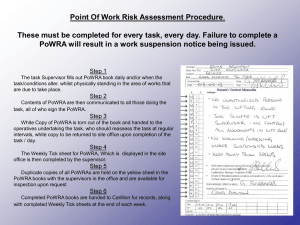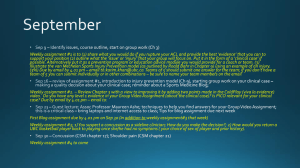Initial planning - Civil and Environmental Engineering
advertisement
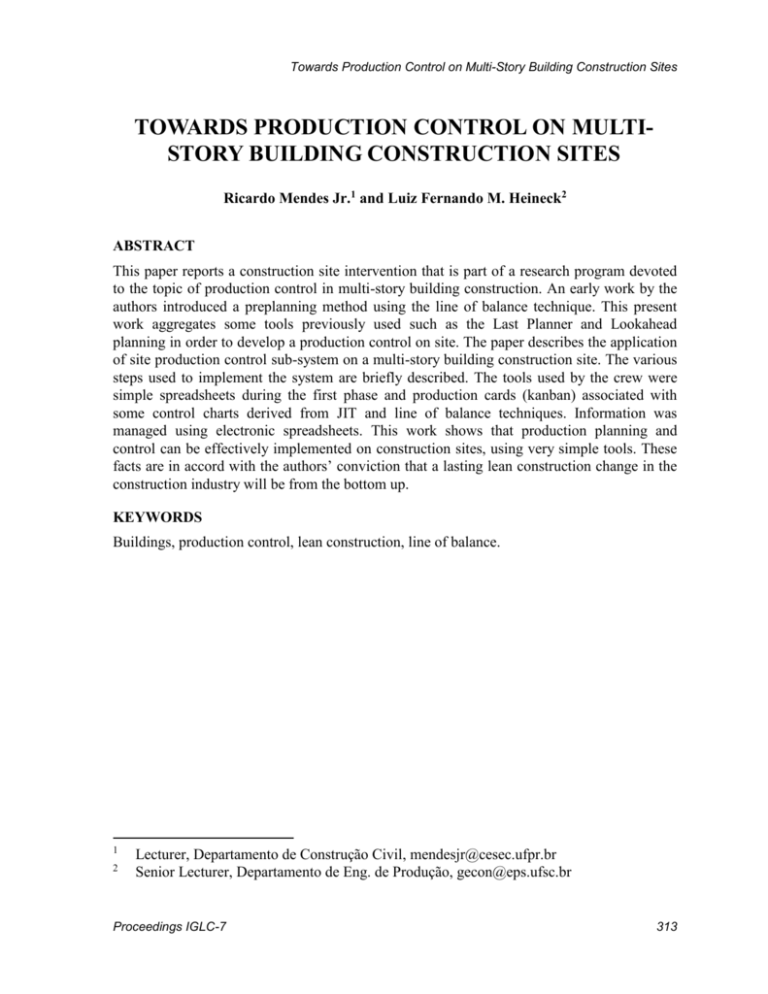
Towards Production Control on Multi-Story Building Construction Sites TOWARDS PRODUCTION CONTROL ON MULTISTORY BUILDING CONSTRUCTION SITES Ricardo Mendes Jr.1 and Luiz Fernando M. Heineck2 ABSTRACT This paper reports a construction site intervention that is part of a research program devoted to the topic of production control in multi-story building construction. An early work by the authors introduced a preplanning method using the line of balance technique. This present work aggregates some tools previously used such as the Last Planner and Lookahead planning in order to develop a production control on site. The paper describes the application of site production control sub-system on a multi-story building construction site. The various steps used to implement the system are briefly described. The tools used by the crew were simple spreadsheets during the first phase and production cards (kanban) associated with some control charts derived from JIT and line of balance techniques. Information was managed using electronic spreadsheets. This work shows that production planning and control can be effectively implemented on construction sites, using very simple tools. These facts are in accord with the authors’ conviction that a lasting lean construction change in the construction industry will be from the bottom up. KEYWORDS Buildings, production control, lean construction, line of balance. 1 2 Lecturer, Departamento de Construção Civil, mendesjr@cesec.ufpr.br Senior Lecturer, Departamento de Eng. de Produção, gecon@eps.ufsc.br Proceedings IGLC-7 313 Mendes and Heineck INTRODUCTION Most construction projects are scheduled based on some sort of critical path planning method (CPM). A number of versions of this technique have been developed and are used as the basis for many of the popular project management software packages. Many researchers discussed the suitability of CPM for construction projects, mainly those repetitive projects, such as railroads and multi-story buildings, and more recently for the lean construction concepts. As the project becomes more complex, this network will become more complex as well. Usually such master schedules cannot be accurately detailed too far into the future because of lack of information about actual duration and deliveries. Other important disadvantage relies on the main idea of the CPM method that is focused on finding the path which is critical. The schedule is developed based on this premise and the resource capacity and material requirements are input for the project simulation. The emphasis is on project duration shortage and resource leveling (Melles and Welling 1996). One production scheduling and control technique that tries to surpass the CPM difficulties for multi-story building scheduling is the line of balance (LOB) technique. An early phase of the research conducted by the authors aimed to improve the LOB concept on building construction and prove its usefulness. The lessons learned from the first jobs helped the efficient use of simple information for the planning of multi-story building projects. One of the results of this research was a initial planning (preplanning) method for multi-story buildings (Mendes Jr. and Heineck 1998). Another deficiency of CPM techniques in terms of construction control is the difficulty of implementing short term planning. The amount of information in order to do short term control with CPM makes it difficult to keep track. The newest part of the research involved the development of a production control information system for the whole process of planning, scheduling and control (Mendes Jr. 1999) combining initial planning with line of balance and short term planning. The production control method uses the Last Planner concept and the Lookahead planning together with some control techniques from JIT techniques and LOB, namely the scheduling panel with production cards (kanban) and the progress chart. The scheduling panel is used to arrange the production cards and the progress chart to view the achievement of the execution goals. PROJECT A practical application was conducted on a multi-story residential building construction site (Rio Mackenzie building). The constructor is Irmãos Thá S/A construction company and is situated on the town of Curitiba (Brazil). This company has a very well organized management process and information system, including cost planning data based software. All the projects have a detailed activities planning and budget, a cash-flow and procedures to control the actual resources expenses - financial, some important materials and labor hours. These planning and management procedures are mainly done by a Planning and Production Control Department (PCP). The PCP department does all the preceding planning work before the execution begin, and has no actual involvement with the construction site staff in order to 314 26-28 July 1999, University of California, Berkeley, CA, USA Towards Production Control on Multi-Story Building Construction Sites aid the construction site planning during the execution. This construction site specially has many pilot projects under development, such as ISO 9000 certification, material management system, among others, which contributed for the immediate agreement on applying these production control tools. The building has twenty one-floor apartments, with 20,500 m2 of floor area, which its finishing materials and design details are tailored to customer’s requirements. When the intervention begun, in November 1998, the building tower had all concrete structure and bricklaying done. The project completion date was scheduled for September 1999. Actually there are around 50 professional workers on site, being 50% sub-contracted for different finishing services. IMPLEMENTATION PHASES The implementation of the production control tools had three phases: First month. It was used only the short-term weekly planning using the Last Planner (Ballard 1994) and the Foreman planning (Laufer et al. 1992). The foreman together with the crew supervisors is responsible for the detailed task planning for a new coming week. During this first month the planning was done together with the site engineer on a weekly meeting in order to train the staff. No formal training of any type was taken prior to implementation; Second month. It was incorporated the medium-term planning, using the Lookahead planning (Ballard 1997). The Lookahead duration was set to six weeks. The background support to these planning tools was done by one of the researchers who maintained all the information on the spreadsheets of the SIPP system; Third month. It was incorporated the use of the scheduling panel and production cards and the progress chart. The weekly plan spreadsheet is substituted by the production cards that are scheduled on a continuous basis. An assistant worker continues to do the weekly planning verification. The production cards of the executed tasks are placed on the progress chart. INITIAL PLANNING This project already had a master scheduling done by the site engineer. Another line-ofbalance scheduling was developed using the Excel based model MIP (Mendes Jr. 1998). This new scheduling does not agree exactly with the one made by the engineer, but had proved to be useful during the work. The methodology used to develop this line-of-balance initial planning and the its main characteristics are described on a previous work by the authors (Mendes Jr. and Heineck 1998). FIRST MONTH - WEEKLY WORK PLANNING In the first month, weekly work planning was performed using spreadsheets filled manually by the foreman together with the site engineer. It was used a weekly meeting which served as training session assisted by one of the researchers. The weekly plan was adapted from Ballard Proceedings IGLC-7 315 Mendes and Heineck (1997) for the use on multi-story buildings. In the present case the activity is a group of tasks related to a unique product built on the construction site and is identified on the initial scheduling. The tasks are identified by an operation within the activity and the apartment (floor) where it will be done. Figure 1 shows the weekly plan for the week beginning at March, 22nd. In the day columns (“Seg, Ter, Qua, Qui, Sex”) it is indicated the place where the task will be executed. In this week it can be seen that the first operation (“Fiação elétrica”) has two tasks executed, indicated by the number 2 on the task (“Tar”) column. The apartments are indicated on the day columns: 601 and 701, respectively at the 6th and 7th floors. In the weekly plan spreadsheet two of the measurements to trend improvements in the efficiency of the planning and execution are used. One is the PPC (Percentage of Planned Complete tasks) and the other is the Problems for non-completion of tasks. These measurements are explained further. The quality assurance and labor manhours are not documented on this spreadsheet because they were already recorded by the company on another sheet, called Quality of Execution Control. Início : Plano semanal N. 1 2 3 4 5 6 7 8 9 10 11 12 13 14 15 16 17 18 19 20 Atividade Fiação elétrica Prumada elétrica e telefônica Tubulação A. P. e ralos 2 SS Calfino Contrapiso escada Gesso corrido Azulejos (coz+lav+bwc emp) Mármore em parede Impermeabilização Pastilha na fachada Forro de gesso Granito em piso Piso ceramico Granito em piso bwc soc e suite Massa corrida e lixamento Retoque de azulejo Rejunte pastilha Suporte para pias Chumbador nas sacadas Piso do subsolo TOTAL = Equipe M C Castelo M C Castelo Toledo Monza Monza Monza 135o 135o Cembra Triue Moria 135o 135o 135o Geraldo 135o Triue Zé Raul Zé Raul Tam. 2 1 1 2 1 1 1 1 1 2 2 1 1 1 3 1 2 2 2 22/Mar Seg Ter PPC= Qua 601 Qui Sex 701 101 a 1001 SS 1501 1601 1701 1201/1601 1201 1301 1401 1501 1901 1301 1801 1401 1701 1501 1601 1601 201 501 1601 2001 1301 cx ag 1201 1201 301 601/701 801/901 1001/1101 901 1001 1101 601 701 cx ag 601 a 1501 201/1001 contratar empreiteiro 28 84% Tar 2 1 1 3 1 5 1 1 1 4 4 1 1 8 3 3 1 1 1 1 Concl. 2 1 3 1 5 1 1 4 1 1 8 3 3 1 1 1 - 44 37 Problemas Categ. empreiteiro faltou Pessoal faltou material Material empreiteiro faltou 3 dias Pessoal Figure 1: Weekly Plan SECOND MONTH - LOOKAHEAD PLANNING The main purpose of the Lookahead planning is the identification of assignments by the foreman and the site engineer, the scheduling of those assignments, and the identification of actions needed to make the assignments sound as regards material, design, or prerequisite work (Ballard 1997). In the application of Lookahead planning to multi-story building construction the authors found that there are two distinct phases. The first one covers the period from the beginning of 316 26-28 July 1999, University of California, Berkeley, CA, USA Towards Production Control on Multi-Story Building Construction Sites the construction up to some date prior to finishing services. In the present case this first phase ended in April 1999, four months before the completion date. The second phase goes up to the completion date of the building. In the context of the line of balance method the main differences between these two phases are: During the first phase the main activities have different rhythms and are developed almost without interruptions. The Lookahead planning may follow the initial planning and looking for assignments into the main activities described on it. Even if the duration of this phase is short enough to produce many interrelations among activities the workflow is not so difficult to be established. The line of balance may result on non-parallel scheduling if the duration of this phase is large; After the first phase there were a few main activities of the initial planning to be executed, but the number of different operations into each one increases a lot. The initial planning does not serve any more as a guide for operations scheduling. The solution achieved for this problem was to visualize a completion rhythm for the residential units abandoning the execution rhythm for each activity. In order to complete each residential unit all the operations are listed, and a new activity schedule is developed for each unit. Many of the operations still are executed repetitively, but the right sequence is selected based on the completion dates. Lookahead duration was set at six weeks. This duration was chosen initially under the assumption that the first phase described above on which a larger looking forward was possible. At the time when this paper was written the second phase was on the right beginning and there are no conclusion about the application of the method until the end of the project. During this second month Lookahead plan was performed utilizing a simple spreadsheet. This spreadsheet is updated on the same weekly meeting for six weeks beginning after the week of the weekly plan. As in the weekly plan the tasks on the Lookahead plan are identified by the activity or operation and the apartment (floor) or any other local on the site. Figure 2 shows the Lookahead plan beginning in the week of 29-3-99. The right sequence of the apartments are indicated on this plan, considering previous working being done on a floor or information not available about tailored finishing materials. This spreadsheet was updated on the computer only for aiding the staff work. The initial planning was consulted on a large sheet kept on the site office wall. Proceedings IGLC-7 317 Mendes and Heineck COD. ATIVIDADE CHUMBADOR P/ EQUIPE INÍCIO FINAL ZÉ RAUL 08/Mar 19/Mar 29/Mar 05/Abr 12/Abr 19/Abr 26/Abr 03/Mai 501 601 701 501 601 701 101 801 901 1001 801 901 1001 1101 1201 1301 1101 1201 1301 1401 1501 1601 1401 1501 1601 1801 201 301 401 201 301 401 2001 1601 1801 2001 AT 101 SACADA 4.06 ESQUADRIAS DE THÁ 05/Abr 27/Mai THÁ 05/Abr 31/Mai MONZA 25/Jan 31/Mar ALUMÍNIO 4.10 VIDROS 5.02 CALFINO 1901 AT 5.06 AZULEJO 135o 18/Jan 31/Mar 101 1301 5.07 MÁRMORE EM 135o 25/Jan 1701 10/Fev 19/Abr GESSO BWC 6.04 PASTILHA NA 1801 1501 TRIUE 08/Mar 23/Abr FACHADA 6.06 PEDRAS EM 1401 29/Mar FACHADAS 7.05 PISO CERÂMICO MENOS HALL SERVIÇO 7.06 GRANITO EM 135o PISO KIT DE LAREIRA 17/Fev 17/Fev 101 501 401 1801 1701 1401 1301 1101 1001 701 601 1501 1701 1901 AT 301 201 03/Mai 1401 1301 1601 1501 1801 1701 2001 1901 101 AT 1401 201 301 1601 601 701 1801 2001 101 1001 1101 1401 1501 1801 1901 401 501 801 901 1201 1301 1601 1701 2001 101 05/Mai ZÉ RAUL 22/Mar 1501 1701 1901 1901 101 101 2001 AT 1301 1001 701 401 1201 901 601 301 1101 801 501 201 2001 1901 1601 1501 1301 1201 901 801 27/Abr 1301 135o 1401 18/Mar PAREDE 5.08 FORRO DE MORIA AT 09/Abr Figure 2: Six weeks Lookahead Planning THIRD MONTH - PRODUCTION CARDS (KANBAN) The use of production cards (kanban) substituted the Weekly plan spreadsheet and its main purposes are: give more visualization for the scheduled plans and make the process run continuously. The visualization is achieved by the use of the schedule panel where the production cards are placed. The schedule panel used in the present case is derived from that one suggested on JIT implementation techniques, and is showed in Figure 3. The panel has three different areas. On the red area on the panel are placed the cards of tasks which still has problems which does not permit it to be scheduled. The card of the tasks on the yellow area are committed by all the involved persons to be executed on the scheduled week but it still not with all the problems solved on site. And the cards on the green and white areas are scheduled and with no problems in order to be executed. The green area represents the actual Weekly plan. 318 26-28 July 1999, University of California, Berkeley, CA, USA Towards Production Control on Multi-Story Building Construction Sites 12-Apr 05-Apr 29-Mar 22-Mar 15-Mar 08-Mar R R R R R R Y Y Y Y Y G Y Y Y Y Y Y G G G G G Figure 3: Schedule Panel (R = red, Y = yellow, G = green) The schedule panel was placed on a unique local with all the tasks being showed on it. The production card has all the information for the crew to execute them. A simplified production card was developed for this application, showed on Figure 4, stating the activity, the location of execution (number of apartment or any other local), the name of the sub-contractor or the supervisor, the date of the beginning of the week and the day of the week to conclude the task. Other necessary information is already kept by the company on other documents. All the production cards were printed for all initially planned operations in the apartments, leaving spaces to the foreman complete the required information. After the task is executed the foreman crosses the actual day on which it was concluded, signs the card and gives to the assistant worker in order to point it on the Weekly plan report and then on the progress chart. Operation Calfino Local of execution 1401 MONZA 08-Mar Seg Ter Beginning of the week Qua Qui Sex Sub-contractor or supervisor Figure 4: Simplified Production Card The further use of the JIT concepts on the production control may lead to the introduction of other cards as the material requisition card and the supplier card. However it was observed that these cards are more difficult to apply as it needs a more broad implementation of Lean Thinking concepts and the involvement of a major part of the organization and supply chain. Proceedings IGLC-7 319 Mendes and Heineck MEASURING PLAN EXECUTION Performance indicators were also established for the purpose of continuous measurement and feedback for learning and improvement within the project. They used metrics proposed by other researchers (Kartam, et al. 1997, Ballard 1998, Miles 1998) described below. All these measurements were automatically calculated by the spreadsheets of the information system and tracked graphically. Some of these records were presented along with the number of scheduled task on each week or the total number of workers. No influence between the amount of tasks or workers and the measurements were detected. Due to the limitation of space the measure graphs are not presented. LOOKAHEAD PLANNING PERFORMANCE MEASUREMENT The Lookahead plan is the key element to keep the initial or master schedule on date. It is the link between the initial schedule and the weekly plan. The Lookahead plan performance is related to the initial schedule was done by two measurements: Percent of Scheduled Assignments (PAP - Percentual de Atividades Planejadas) In the present case, this measure is calculated in number of apartment scheduled for each activity. The ratio of the number scheduled and the planned number stated by the initial schedule gives the value of PAP. In order to give an overall performance measure, all the number of apartments scheduled are summed and also all the planned number of apartments for the activities. The ratio among these two summations, subtracted of 1, gives the overall PAP of the Lookahead plan. Thus, PPA indicates how far is the Lookahead from the initial schedule. If PAP is equal 0 it indicates that the Lookahead plan is on the schedule. If PAP is negative indicates that is behind the schedule. During the intervention PAP stayed around -10% from the beginning up to March/99. During April/99 it decreased to -20% because the site engineer postponed many decisions about the concluding activities. In the present case another value for PAP was computed, called PAP+, using the free slack for the activity defined by the line of balance schedule. The actual value of this PAP+ is around -5%. Percent of Scheduled Assignments Planned (PPA - Percentual de Programação das Atividades) In the present case, this measure is calculated as the number of tasks that appear on the weekly plan and are scheduled on the Lookahead plan. This measurement indicates the efficiency of the Lookahead plan on supporting the Weekly plan. PPA is calculated for each week of a Lookahead period. An average PPA for all the Lookahead plan is the mean of the six calculated percentages. During the initial part of the intervention the average PPA stayed around 85%. The extent of tasks not scheduled on Weekly plans has relation to decisions pertaining to the site engineer and that usually stayed without clear definition. Actually the average PPA increased to around 95%. 320 26-28 July 1999, University of California, Berkeley, CA, USA Towards Production Control on Multi-Story Building Construction Sites EXECUTION PERFORMANCE MEASUREMENT Percent Planned Complete (PPC - Percentual de Tarefas Planejadas Completadas) Planner records percent complete of all tasks on the weekly plan at the end of each week. It was stated that tasks might be planned to achieve three status: (1) all of the apartment (100%), (2) approximately half part of it (50%) or (3) a beginning part of it (less than 20%). This different status was used more to tasks performed over the entire apartment to avoid the need to calculate construction volume, thus keeping the procedure simple to implement. Figure 5 shows the PPC performance along the intervention. PPC averaged around 89%, but it can be seen that in the early stage of the implementation it was lower. Indeed, from 16-Nov to 25-Jan, the number of scheduled tasks was successively increasing and the PPC averaged 84% and the number of non-completed tasks averaged six per week. After 25-Jan, the average PPC is around 92% and the number of non-completed tasks is around two per week. This fact shows that training by doing has succeeded. 100% 80 70 90% 60 PPC 40 70% Tasks 50 80% 30 20 60% 10 PPC 12/Abr 05/Abr 29/Mar 22/Mar 15/Mar 08/Mar 01/Mar 22/Fev 17/Fev 08/Fev 01/Fev 25/Jan 18/Jan 30/Nov 23/Nov 0 16-Nov 50% Tasks Figure 5: PPC for the Weekly Plans of the Overall Project Problems for Non-Completion of Tasks Logs and charts were kept to show problems with assignments that were not completed as planned. These problems were classified into a number of categories as proposed by many other lean construction researchers. The problem occurrences were grouped into the Proceedings IGLC-7 321 Mendes and Heineck following categories: Accident, Weather, Contract, Equipment, Material, Labor, Scheduling, Design and Preceding tasks. Almost 50% of the problems were due to labor workforce (36%) and material delivering or quality (21%). It could be noted that all these problems had no relation to the production control methodology or crew organization. These problems were mostly related to external factors, such as suppliers, central office, and sub-contractors personnel. Only at the beginning of the intervention some problems related to adequate scheduling were recorded. Actual to Planned Labor Man-hour (MH) After each record of a weekly plan, the actual man-hours per activity are compared with the planned labor. These records were already maintained by the company and are used to validate manpower estimating. Actual to Planned Construction Rhythm (CR) Documents planned total time from the initial planning to complete the part of each activity on the weekly plan. Records actual total time and calculates the ratio between the actual and planned rhythm. This ratio is used to update a total time estimation for each activity. Scheduling Deviation (DP - Desvio da Programação) For the present case this measurement is calculated by the ratio of the number of apartments executed on each activity on each week and the planned number of apartments. As for the PAP measured for the Lookahead plan, DP has another value, called DP+, which incorporates the free slack stated on the initial schedule for each activity. During this intervention the DP always stay around -5%. This very good schedule performance makes it unnecessary to present the DP+ value! SUCCESS OF IMPLEMENTATION The success of the implementation may be measured in two ways. One of them is the high value obtained for the performance measurements showed above. However this does not measure the acceptance, understanding and involvement of the staff with the new information tools. In order to investigate this subject, a questionnaire survey was developed and administered. This questionnaire showed that the new tools were fully accepted and understood by all the management staff of the site. The overall average on all the questions resulted on a 4.6 score, on a scale from 1 to 5. INFORMATION SYSTEM The information system was fully developed on electronic spreadsheets. The original model—MIP (Mendes Jr. 1998)—included information on the budget, activities precedence, construction volume estimation, man hour estimation, line of balance scheduling with early and late date computations and line of balance weekly chart. 322 26-28 July 1999, University of California, Berkeley, CA, USA Towards Production Control on Multi-Story Building Construction Sites On this system, a spreadsheet for progress scheduling was incorporated and updated based on the units (apartments or floors) concluded for each activity, which shows the execution performance measurements, and predicts new activities duration without reprocessing all the schedule. The activities are also re-scheduled based on the information on the actual Lookahead plan. This procedure is much simpler than using CPM software and demonstrated useful and sufficient. The system also keeps all the weekly records for the Weekly plans, the Lookahead plans, execution performance measurements, Lookahead performance measurements, and problems associated with non-completion. These records permit many useful analysis towards continuous learning and the decision making process. This possibility is well described by Miles (1998) for a small project in USA. During this intervention all the software tools were operated by one of the researchers. The next step would be to package the software into an adequate tool for the end user utilization. The researchers still do not have conclusions about what would be an adequate tool for doing this. It may be a database, spreadsheet or project management tool, combined with object oriented or knowledge based components. All of these were used in the past, but none leads to the ultimate solution. CONCLUSION This paper presented a practical application of a production control information system on a multi-story building construction site. This system was developed using key tools and concepts that had not been given much attention by researchers and professionals in the past. One of these tools is the line of balance technique specially suited for repetitive projects. Another tools are that one developed under the concepts of which is actually know as Lean Thinking. In this case are the Last Planner or the Foreman planning concept (“the person who makes things happen”), and measuring and improving planning performance on the construction site (“begin as soon as possible with an important and visible action”). (citations from Womack and Jones 1996 and Howell and Ballard 1998). This work showed that production planning and control could be effectively implemented on construction sites, with a staff that are lean thinking novice and using very simple tools. The intervention showed also that no involvement of the office staff of the organization is needed during the construction to organize the production process, however a great commitment of some departments is needed for the goal achievements. On this aspect, the production control information system implemented gives more updated information in order to aid the planning process of these departments. Despite of the tools simplicity, the amount of information needed is increasing providing an information flow that may lead all the management information for the planning process on the construction company. These facts are in accord with the authors’ conviction that a lasting lean construction change in the construction industry will be from the bottom up. This conviction is enforced by this advice: “Take care to develop systems thinking, understand the difficulty of changing mental models, expect deep resistance in yourself and others to decentralized decision making, and learn about production management” (Howell and Ballard 1998). Proceedings IGLC-7 323 Mendes and Heineck ACKNOWLEDGEMENTS The authors gratefully acknowledges the contribution of the following persons for all their aid on this case study project, for courage and commitment to a “better way”: Gilberto Kaminski (planning dept. manager), José Roberto F. Souza (site manager) and Nelson do Espírito Santo (leader foreman); and also the great support received from Irmãos Thá S/A staff since the very poor beginning of our work many years ago. We thank also to the financial supporting of CAPES and our organizations, UFPR and UFSC. REFERENCES Ballard, G. (1997). “Lookahead planning: the missing link in production control.” Proc. 5th Ann. Conf. Intl. Group for Lean Constr., pp. 13-25, Gold Coast, Queensland, Australia, http://www.vtt.fi/rte/lean/. Howell, G. and Ballard, G. (1998). “Implementing lean construction: understanding and action.” Proc. 6th Ann. Conf. Intl. Group for Lean Constr., Guaruja, Brazil. Kartam, S., Ballard G., and Ibbs, C.W. (1997). “Introducing a new concept and approach to modeling construction.” J. Constr. Engrg. and Mgmt., 123 (1), Mar, 89-97. Laufer, A., Howell, G.A., and Rosenfeld, Y. (1992). “Three modes of short-team construction planning.” Constr. Mgmt. and Econ., 10, 249-262. Lutz, J.D. and Hijazi, A. (1993). “Planning repetitive construction current practice.” Constr. Mgmt. and Econ., 11, 99-110. Melles, B. and Welling, D.T. (1996). “Towards a different view on production control in construction.” Proc. 4th Ann. Conf. Intl. Group for Lean Constr., http://www.vtt.fi/rte/lean/. Mendes Jr., R. (1998). “Spreadsheet model for building construction scheduling-new developments.” (in Portuguese) Proc. National Conference on Technology for Built Environment - ENTAC 98, Apr 1998, Florianópolis: UFSC, 671-678. Mendes Jr., R. and Heineck, L.F. (1998). “Preplanning method for multi-story building construction using line of balance.” Proc. 6th Ann. Conf. Intl. Group for Lean Constr. Mendes Jr., R. “Production control on multi-story buildings construction.” (in Portuguese) Doctoral Diss., to be published, Federal Univ. of Santa Catarina, Florianópolis, Brazil. Miles, R. (1998). “Alliance lean construction design/construct on a small high tech project.” Proc. 6th Ann. Conf. Intl. Group for Lean Constr., Guaruja, Brazil. 324 26-28 July 1999, University of California, Berkeley, CA, USA
